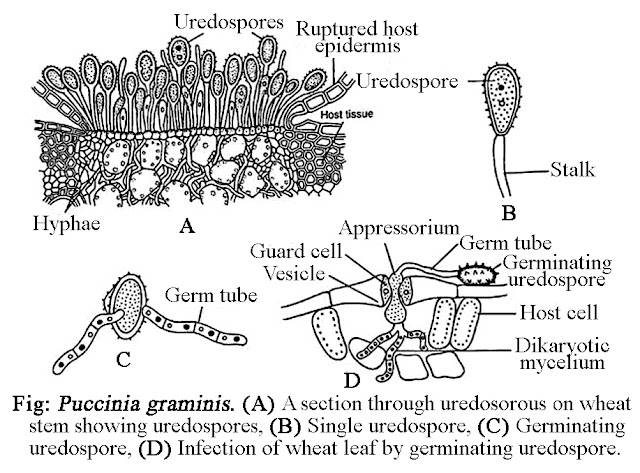ECTOCARPUS - STRUCTURE OF VEGETATIVE BODY AND REPRODUCTION
A. CLASSIFICATION:
Division – Phaeophyta
Class
– Isogeneratae
Order
– Ectocarpales
Family
– Ectocarpaceae
Genus
– Ectocarpus
Ectocarpus is the most primitive of all
brown algae and comprises of many species. A few of them (about 6) have been
reported to occur in fresh water. The marine species is world-wide in
distribution but are found in abundance in colder seas of temperate and polar regions.
The plants occur attached to the rocks and stones along coast in both littoral
and sublittoral zones. Some species occur in shallow water on the sides of the
tidal pools. Some species grow as epiphytes on other algae especially along
with Fucuales and Laminariales (E.
coniferus and E. breviarticulatus). E.
fasciculatus is found to grow on the fins of certain fishes in Sweden.
About 16 species of Ectocarpus have been reported from
India. Some of the common Indian species are – E. coniferus, E. indicus,
E. arabicus, and E. dermonematus.
B. STRUCTURE OF THE VEGETATIVE
BODY:
The vegetative body i.e., the
thallus of Ectocarpus is a small septate,
heterotrichous filament, differentiated into two parts – the prostrate or creeping portion and the erect or projecting portion.
The prostrate portion
in epiphytic species is irregularly branched and sticks to the substratum by
rhizoids. In aquatic species, the erect system arises from the prostrate part
and waves freely in water. The branching of the thallus is always lateral. The branches arise just beneath
the septa. Growth of the prostrate
portion is apical but the growth of
erect portion is intercalary.
In a filament, cells are joined
end to end in a single series. The cells of Ectocarpus
are semi-oval to rectangular in outline. It consists of two walls – outer wall composed of pectin and inner wall composed of cellulose.
The characteristic gelatinous substance algin
and fucoidan is also present in the
cell wall of Ectocarpus.
Each cell is uninucleate and
consists of few chromatophores and pyrenoid-like bodies. Mature cell also
contains numerous large vacuoles and
also some small vesicles. The pigments
present are – fucoxanthin (brown
pigment), chlorophyll-a, chlorophyll-b
and β-carotene.
C. REPRODUCTION: Ectocarpus reproduces both
by asexual and sexual methods of reproduction.
1. Asexual Reproduction:- Asexual reproduction takes place by the formation of biflagellate zoospores
produce within the zoosporangia,
borne singly within the tip of lateral branchlets of the sporophytic plant
body. Zoosporangia are of two types – unilocular
and multilocular zoosporangia.
(a)
Unilocular Zoosporangia:- It is produced by the enlargement of terminal cell of lateral branchlet. The
single nucleus of the terminal cell divides and redivides producing 32 or 64 nuclei. The first division of
is meiotic, followed by repeated mitotic divisions. Next the cytoplasm of the
young sporangium undergoes cleavage into uninucleate daughter protoplasts, each with a single chromatophore. Each daughter protoplast is then metamorphosed into
haploid, uni-nucleate, pear-shaped, biflagellate zoospores (zoomeiospores).
At maturity the zoospores escape all at one time through a small opening formed at the distal end of the sporangial wall.
(b)
Multilocular Zoosporangia:- It is multi-chambered body developed on the terminal cell of the young
branchlets of diploid sporophytic thallus. The terminal cell becomes long and
enlarged and numerous chromatophores accumulate. It then undergoes repeated
transverse and longitudinal divisions to form a series of small, cubical cells
forming multilocular sporangia. The
protoplast of each cell is then directly metamorphosed into single uni-nucleate,
biflagellate, diploid zoospores (2n).
At maturity the diploid zoospores
escape all at one time through a small opening formed at the distal end of the
sporangial wall.
Both haploid and diploid
zoospores take a short period of rest after liberation. After the rest period
is over they start germinating. The germination of haploid zoospores produces haploid
gametophytic plant, while the germination of diploid zoospores produces diploid
sporophytic Ectocarpus plant.
2. Sexual Reproduction:- Sexual reproduction is of both isogamous
and anisogamous type. Isogamy occurs
in homothallic species and anisogamy occurs in heterothallic species. Oogamy is
absent. Gametes are produced in large numbers in elongated, multilocular bodies
called gametangia. The gametangia are
formed only on haploid gametophytic
thallus, which developed as a result of germination
of haploid zoospores formed in unilocular
sporangium.
The gametangia resemble that of
multilocular zoosporangia. They are either sessile or short stalked. Each
cubical cell of the gametangium contains a single
haploid nucleus, which metamorphoses into a single haploid gamete.
The gametes are
pear-shaped, biflagellate structure. The flagella are unequal in length.
Liberation of gametes take place through the terminal pore formed in the
gametangium wall.
(c) Fertilization:- Fusion takes place between two
gametes of morphologically similar structure (isogamy) or gametes of morphologically dissimilar structure (anisogamy). In isogamy, the identical
gametes are produced in the same gametangium of homothallic species (E.
golifer). In anisogamy, the differential gametes are produced in different
gametangia of heterothallic species (E. secundus).
As a result of fusion, a diploid zygote(2n) is formed, which
directly germinates into a new diploid sporophytic Ectocarpus plant which bears both unilocular and multilocular
sporangia.
************









Amazing Sir
ReplyDeleteSir gametangia are formed on plurilocular sporangia sir
ReplyDelete